19th Century Timber Frame Revival Buildings
Tim Nicholson
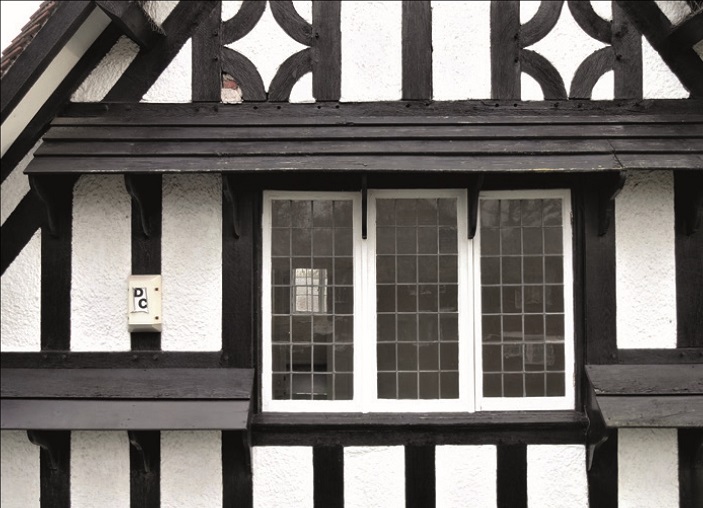 |
| A black and white timber frame gable in Port Sunlight, typical of late 19th and early 20th century construction, with rough cast render panels on a brick backing (All photos: Tim Nicholson) |
Architectural writers have used various terms to describe the proliferation of late 19th and early 20th century buildings often referred to as ‘half timbered’ but few give these buildings more than a cursory mention. Sometimes considered as 19th century architectural imposters, these products of the Arts & Crafts movement differ significantly from the timber framed buildings typical of the 16th and 17th centuries in construction and material, yet anyone involved in the care of these buildings will find little published material to help them understand these differences.
DEVELOPMENT
Timber frame or ‘half-timber’ revivalism superseded the high Victorian style of architecture typically characterised by the Gothic Revivalism of the mid-19th century. By the 1860s half-timbered buildings were becoming common, although elements of Gothic are often included in the architectural composition.
Some of the best examples of timber frame revivalism can be found in Chester. Its much-photographed city centre is largely the result of a small number of 19th century architects including John Douglas and Thomas Lockwood who used ‘half timbering’ to produce the iconic streetscape that can be seen today. Many of these buildings rub shoulders with earlier timber frame buildings and the casual observer can be forgiven for mistaking the Victorian picturesque style for something much older. Urban post-medieval timber frame buildings were often given a 19th century makeover to match the newer surrounding half-timber building, although the earlier origins of the building are normally apparent from an internal inspection.
Many of these buildings are very high quality in their design and execution and despite some early criticism from architectural commentators, many now receive statutory protection.
While there are certainly similarities between these buildings and the earlier timber frames, a number of differences are not necessarily apparent from a purely visual assessment.
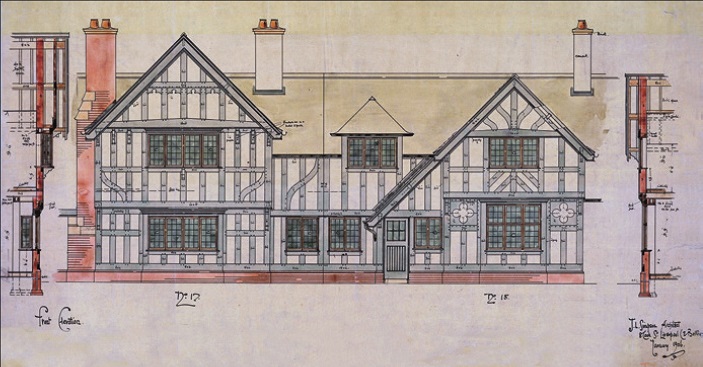 |
| Working drawings made in 1906 for housing in Port Sunlight (Reproduced by kind permission of Unilever Archives and Records Management) |
Early post-medieval timber buildings are the result of a constructional expedient rather than any deliberate design intent. Timber was abundant at that time and usually available locally, and despite carpentry skills being well established, embellishment of the frame was mostly reserved for the very highest status buildings. This position contrasts noticeably with the 19th-century timber frame buildings where decoration of the exposed timber is often profuse, even on fairly modest buildings.
By the 19th century, the old building traditions had mostly been replaced and architects were routinely being used to design everything from country houses, pubs, farms and schools, many of these using elements of timber framing.
Stylistically, the framing conforms to the close stud or box frame patterns and the two are often blended within the same building, sometimes incorporating elaborate carved details. It is only when the original architect’s drawings are inspected or where a building is opened up for alteration or repair that the constructional differences between these buildings and the earlier timber frames become apparent.
Unlike the earlier timber frames, 19th century timber framing is often confined to a single elevation, typically a prominent gable. Significantly the timber frame is usually only partly structural, with elements of the framing providing little or no support or bracing. Architects were fond of incorporating the more technically challenging and visually striking elements of the earlier frames and multiple jetties are quite common, particularly in urban settings. It is also common to find that the ground floor is constructed from solid masonry, while the upper storeys are fully or part timber framing.
Understanding the method of construction is vital when trying to anticipate how the building might perform when defects develop, and when designing repairs and alterations. Original construction drawings may sometimes be available, but a detailed physical inspection should always be undertaken as there can be considerable variation in the construction methods.
MATERIALS
The palette of materials available to the builders of post medieval timber frame walls was restricted to what was locally available: essentially this was timber, earth daubs and lime plasters. By the end of the 19th century advances in building technology and the introduction of new building materials meant that the new generation of timber frame buildings included a much wider and more sophisticated range of materials.
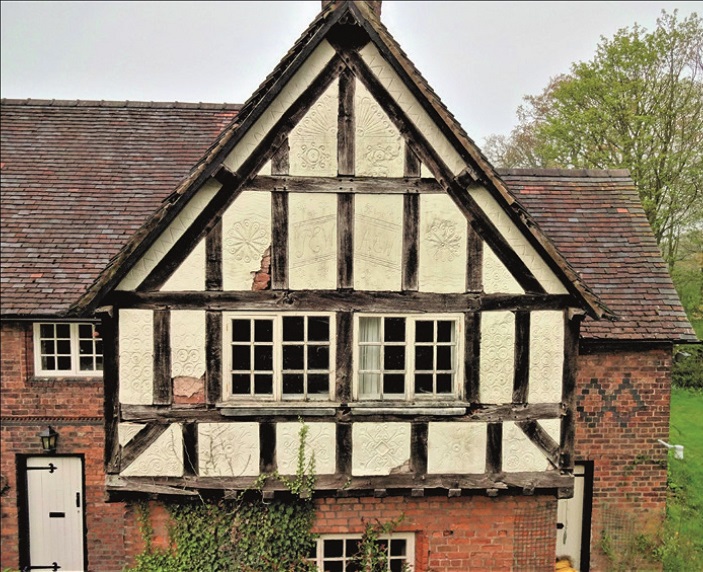 |
| A late 19th century jettied upper storey which had deteriorated due to inadequate design and timber decay |
Structural frame members (often limited to principal rafters, tie beams, sill beams and collars) are generally oak, which tends to be used straight from the saw with little or no surface finishing. Pegs for securing the joints are also oak and sizes vary but contemporary specifications for houses built at Port Sunlight village prescribe pegs of one and one eighth inch (29mm) diameter to project one and a quarter inches (32mm) from the face of the framing.
Non-structural posts and braces are generally oak but not exclusively and softwood was also used. Various species of timber plastering laths were used and from the late 19th century expanded metal lath was used, especially in the formation of covings. Ferrous metal fixings are common and these tend to be ungalvanised iron or steel.
Infill panels are commonly rendered. Depending on the type of construction this may be applied over either solid brick or lathing. The type of render varies but ordinary Portland cement (OPC) was used extensively, sometimes in the form of a hydrated lime putty mortar gauged with OPC.
Rendered panels are sometimes pargetted, the quality and complexity varies enormously from simple incised patterns, to allegorical figures or semi erotic scenes executed in high relief, both styles were completed using lime- and cement-based renders.
Where solid materials have been used to fill the panels, brick is the most common, but several other materials have also been recorded. These include brick veneers and hollow terracotta blocks as well as ‘Terrawode’ blocks produced by Jabez Thompson and Sons Ltd of Northwich, Cheshire.
CONSTRUCTION
The precise method of construction varies from one building to another. Although architects and builders are likely to have shared their ideas and superficially many of these buildings may appear very similar, anomalies in the construction are to be expected. The following is an outline of the type of construction that is likely to be encountered in buildings constructed during the late 19th and early 20th centuries.
A familiarity with 16th and 17th century timber frame buildings is certainly helpful when looking at late Victorian and Edwardian half-timber buildings, but there are a number of significant differences that set most of these buildings apart from their predecessors.
The fundamental difference between the earlier timber frames and the timber frame revival buildings is the thickness and composition of the load bearing walls. Typically the walls of 16th and 17th century timber frame buildings rarely exceed 150mm, whereas timber frame revival buildings typically have an external wall thickness not less than 225mm (nine inches – the length of a standard brick) and sometimes considerably more. As a consequence, many but not all of these buildings have partially composite load bearing walls built from a variety of materials.
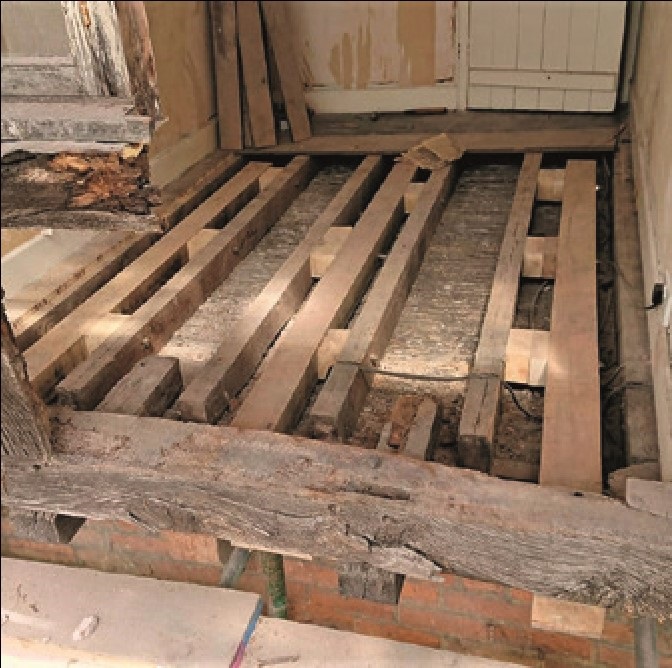 |
| The dismantled timber frame showing new longer jetty joists bolted to existing floor |
Although some of these later buildings were designed and built using the earlier techniques, cost considerations and the requirement to maintain a minimum wall thickness of 225mm in order to prevent water penetration meant that in most cases the timber frame does not extend through the full thickness of the wall. There are exceptions and in some cases full thickness framing has been used throughout the building, or may occur in certain parts of a building, although this is normally concealed by plaster.
Problems of water penetration around the panels of the earlier timber frames was clearly considered by the Victorian architects who were normally careful to include drips on the underside of any projecting beams to prevent water running down the face of the wall. The tops of horizontal timbers are also sometimes protected by lead flashings which are turned up behind the render coat. Where the panels have been rendered the vertical timbers often have a rebate cut into the reverse face, when the render was applied this was forced into the rebate thus concealing any edge shrinkage and minimising the risk of water penetration.
There are variations but in general the principal rafters, tie beams, corner posts and sill beams have similar dimensions to the earlier timber frames although the depth of these timbers is normally restricted to between 100 and 150mm. The remaining posts and rails are typically around 50mm deep, and from 125 to 200mm wide.
In some cases the interstices created by the frame are filled with an arrangement of vertical studs covered with timber laths or expanded metal lathing, this is then rendered over. Behind this there may be a solid brick wall or a secondary stud wall that is set back from the timber frame to produce an effective cavity. In many cases the frame is enclosed in a solid 225mm (nine inch) brick wall which has been constructed around the timbers, any voids resulting from the difference in the depth of the timber and the brick is filled with mortar.
Where the construction includes jetties these are built in much the same way as the historic timber frames with the jetty joists extending well back into the rooms and securely fastened below a cross wall.
In some instances the timber framing is purely decorative and consists of 25 to 50mm thick timbers secured to a solid brick wall, these are normally sunk flush with the surrounding render. Covings beneath overhangs are normally formed from timber laths but these may also be expanded metal lath.
INSPECTION
The protocol for inspecting this type of building is similar to inspecting a fully structural historic timber frame, although unlike the older timber frames, distortions in the frame are uncommon and should generally be treated with suspicion rather than assuming they are the result of initial drying and shrinkage. Because of the composite nature of some of the walls, brick infill or backing should be considered structural until proven otherwise and load paths should be fully established before preparing any specifications. Particular attention should be given to corbels and brackets, projecting windows and jetties.
DEFECTS
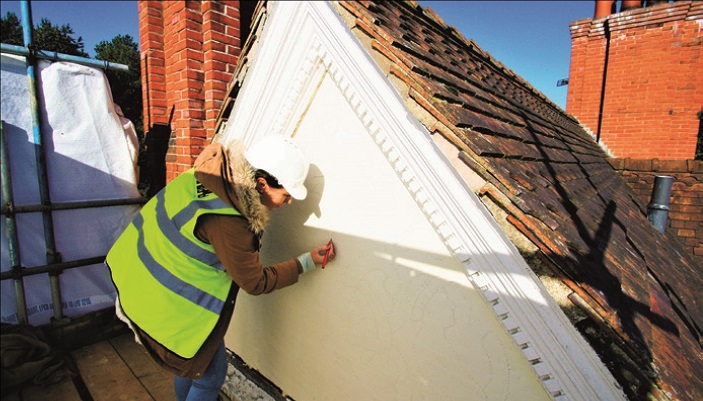 |
| Pargetting repairs being carried out by Lizzie Nicholson-Jones to an 1870s house by John Douglas in Chester |
Unlike the earlier timber frame buildings, problems of water penetration in and around the timber frame were minimised through careful design detailing, however decay remains a problem.
Decay occurs preferentially, and typically affects joints and the vulnerable top edges of horizontal timbers. White rots are most commonly found but these can cause extensive damage even in seasoned oak that has been exposed to long-term water penetration. Dry rot is relatively rare in the frame but does sometimes develop internally as a result of defects in the building envelope.
Render defects are common and are likely to precipitate decay in the timber frame. Cement appears to have been the binder of choice and this combined with modern paint finishes contributes to the decay that commonly affects the edges of the timber frame. High relief pargetting is found on many buildings of this type and is often moulded in Roman or Portland cement. Where this is confined to the upper part of the gable, in order to keep the weight low the backing is sometimes constructed from timber laths rather than brick, due to the weight of the pargetting and the vulnerability of the laths and nails to the effects of water ingress, these panels can occasionally come crashing down.
Due to the nature of the construction, structural problems in the timber framing tend to occur as a result of a failure in the joints around the tie beams and corner posts. However, more serious problems may occasionally occur in the jetty structure. The stability of a jettied storey relies on the ability of the projecting jetty joists to resist the forces applied by the structures above. In the vast majority of buildings the jetty is fairly shallow and free from any defects, occasionally jetties can fail, either because the architect or builder has failed to do their job properly, or because the structure has been compromised in some way. The most likely cause of a jetty failure is a combination of inadequate restraint of the jetty joists and defects in the frame which have caused additional loads to be applied to the horizontal jetty beam. One of the first indications of serious defects in a jetty is a distortion in the floor covering where the jetty joists are rotating over the wall plate causing a characteristic hump in the floor.
REPAIRS AND MAINTENANCE
The type of repairs required will depend to some degree on the significance of the building. Unless there is a clearly identified design flaw which has contributed to the defect, all repairs should be conservative in nature using techniques and materials to match the original work. Subject to the constructional differences previously described, current best practice methods for repairing historic structural timber frames applies to the repair of timber frame revival buildings.
Repairs to the timber frame should be undertaken using traditional timber to timber repairs whenever practical. Subject to approval, isolated pockets of decay in non-structural timbers can be repaired with resin. The use of composite repairs incorporating reinforced shuttered resin and or steel brackets should also be considered for structural timbers where these techniques reduce the loss or disturbance of the surrounding fabric.
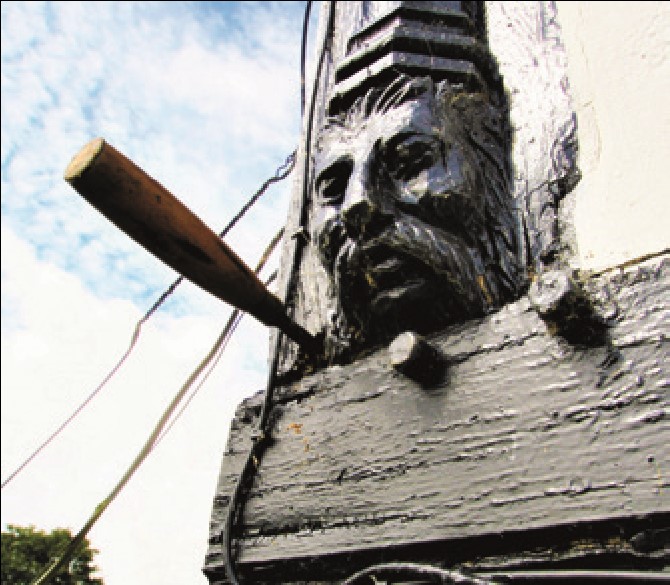 |
| Black paint often conceals timber decay |
Depending on the type of failure, repairs to failed jetty structures may require some degree of re-design or substantial strengthening works. The precise repair methods will vary but in order to complete these type of repairs, considerable opening up is often required.
Where pargetted panels need to be removed to complete a repair, it may be possible in some circumstances to carefully remove the panel complete with its lath backing and re-fix this after the frame repairs have been completed. Where the pargetting has been applied to brick, a full photographic and drawn record should be made prior to dismantling, this should then be used to replicate the original design.
Where extensive repairs are required, there may be a case for replacing brick infill with an appropriate lightweight insulating panel. This decision should consider the historic and visual significance of the brick as well as the structural implications of making such an alteration.
Most of these buildings have been painted in the familiar black and white scheme that contributes to the urban grain of many towns and villages. While there are technical arguments in favour of removing paint and other types of finishes from timber frames, in the case of those buildings that are listed, or located in a conservation area, consent to remove the paint exposing the timber is unlikely to be given.
Recommended reading
AW Jackson, The Half Timber House, Robert M McBride & Co, New York, 1919
E Hubbard, The Work of John Douglas, The Victorian Society, London, 1991
FH Crossley, Timber Building in England, BT Batsford Ltd, London, 1951



